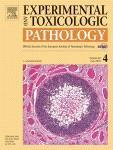Patková J, Vojtíšek M, Tůma J, Vožeh F, Knotková J, Šantorová P, Wilhelm J. Exp Toxicol Pathol. 2010 Jul 1. IF: 1.431

Abstract:
This study was carried out to investigate the role of lead in the development of oxidative stress in the brain. We examined the rate of lipid peroxidation and we determined lipid fluorescence products (lipofuscin-like pigments – LFP) as a marker of lipid peroxidation after short in vitro incubation of rat brain homogenates with lead acetate (10–2, 10–4, 10–6 M lead acetate, 2 h). Simultaneously we examined by the same method in vivo indices of oxidative stress in brains of mice exposed for 12 weeks to 0.2% lead acetate in drinking water.
The results show that the concentration of LFP in rat brain homogenates increased significantly after 2 h incubation with 10–2 M lead acetate as compared to controls (P < 0.0001). This effect was not observed in lower doses of lead acetate (10–4 and 10–6 M). After the long-term exposure of mice to 0.2% lead acetate, pronounced accumulation of lead and significantly increased concentration of LFP (P < 0.004) in the brains of exposed animals as compared to controls were observed. The evidence for the formation of specific fluorophores originating from oxidative damage was shown also in qualitative changes in 3D spectral arrays and synchronous spectra. The presented results proved the influence of lead on the activation of radical reactions in the brain after short in vitro exposure of rat brain as well as within long-term in vivo exposure in mice using lipofuscin-like pigments as an indicator of oxidative stress.
-az-
